Rigs-to-Reefs
Rigs-to-Reefs (RTR) is the practice of converting decommissioned offshore oil and petroleum rigs into artificial reefs. Such biotic reefs have been created from oil rigs in the United States, Brunei and Malaysia.[1] In the United States, where the practice started and is most common, Rigs-to-Reefs is a nationwide program developed by the former Minerals Management Service (MMS),[2] now Bureau of Safety and Environmental Enforcement (BSEE), of the U.S. Department of the Interior.
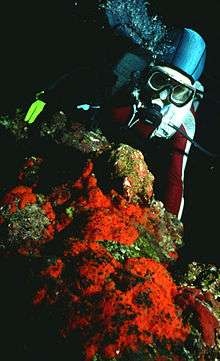
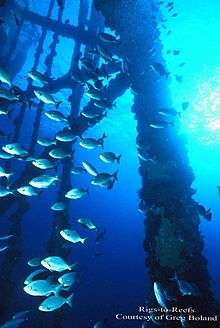
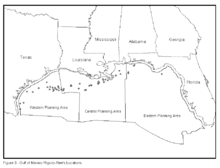
The program has been generally popular with fishermen, the oil industry, and government regulators in the Gulf of Mexico, where offshore platforms develop into coral reefs, and as of September 2012, 420 former oil platforms, about 10 percent of decommissioned platforms, have been converted to permanent reefs.[3]
Opposition in California has prevented a rigs-to-reefs program on the West Coast of the US.[4] Similarly, environmental opposition has prevented implementation of Rigs-to-Reefs in the North Sea.
Overview
Inevitably, marine organisms attach themselves to the underwater portions of oil production platforms, transforming them into artificial reefs.[5]
These platforms continue to function as long as the reservoirs underneath them provide oil at a profitable rate. At the end of their productive lives they must be decommissioned and removed (in the US within one year).[6] An alternative to removal is to turn the rig into a reef through the Rigs-to-Reef (RTR) program.[7] All coastal states in the US have such artificial reef programs in the interest of increasing ocean fisheries but not all participate in RTR.[8][9] The rig's steel structures are stable and durable.[10] They create shelter for marine life in open waters where there was none.[5][11]
Note that production platforms are often called "rigs"; that terminology is used occasionally in this article—and indeed in the term Rigs-to-Reefs. However, within the industry "rigs" refers to apparatus with a derrick that can drill and service wells. (Most production platforms do not have such equipment installed.)
Process
Once a rig stops producing at economic rates, the site is usually abandoned.[12] In the United States, the Minerals Management Service (MMS) requires the operator to remove the rig within a year of abandonment (stopped production[12]) and lease end.[6] MMS supports and encourages RTR as an alternative to total removal.[6] RTR recognizes that during a rig's productive years, significant marine life comes to live on and around its structure. RTR preserves much of that marine life and encourages further growth. The operator benefits by avoiding the substantial cost of removal. Cumulative costs of removal had reached an estimated $1 billion by the year 2000.[10] The shape and complexity of the structure may lead to significant species diversity.
Decommissioning a platform
Officially, decommissioning an oil rig is the act of removal according to regulatory requirements and includes flushing, plugging and cementing wells to make them safe.[12] Decommissioning is complicated by factors such as cost, safety, operational duration, environmental issues, risk, experience, and historical relationship between operator and state.[12]
As part of decommissioning, the operator must deal with the shell mound that collects on the bottom surrounding the rig. The mound forms on the pile of cuttings discharged from the original drilling operations, shells that have fallen from the platform's underwater structure, and material that has fallen and/or leaked from the platform, occasionally mixed with well seepage. Mounds can contain significant levels of toxic metals including, arsenic, cadmium, chromium, copper, nickel, PCBs, lead, zinc, and poly-nuclear hydrocarbons. Removing the rig structure does not eliminate the need to address the mound.[13]
The method of decommissioning depends on water depth and structure type[14] and is a three-step process that includes planning, permitting, and implementation.[15] A party other than the operator usually administers the process.
In Louisiana, costs as well as the risk involved are the primary factors in determining how to decommission rigs. If the savings are large enough, the operator typically chooses reefing and donates 1/2 the savings to maintain the reef.[12] Decommissioning a shallow water rig typically costs $10–15 million[16] so the amounts can be substantial.[17] The Louisiana Artificial Reef program from its inception through 1998 received roughly $9.7 million in donations and has not taken taxpayer money.[18]
Methods of reefing


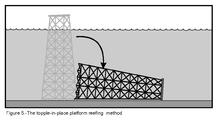
Severing the rig from the bottom using explosives is the easiest approach, but has the potential to harm marine life. This potential is greatly reduced if the explosives are all placed deep below the seafloor. Current requirements place the explosives a minimum of 5 metres (16 ft) below the seafloor which eliminates the threat to all but the closest sea turtles. National Oceanographic and Atmospheric Administration (NOAA) National Marine Fisheries Service (NMFS) marine observers and helicopter surveys hours preceding the event keep most sea turtles away from the area. Alternatively, commercial divers can use mechanical and abrasive cutters, which preserves marine life, but places the divers at considerable risk.[12]
Reefing involves one of three methods.:
- Tow and Place: Sever the structure from the sea floor and tow it to a state-approved location.
- Partial Removal: Remove the top portion of the submerged platform and either remove to the shore for salvage or place it on the sea floor nearby or at another site.[10] Partial removal can result in a loss of the shell mound community and fish that live in the top section but the rest (the majority) of the habitat remains intact.[15]
- Toppling: Toppling involves uses explosives to sever the base of the structure below the mud line in a matter such that it simply falls over. Toppling eliminates shallow and mid-ocean habitats. However, these portions of the rig are quickly occupied by other creatures.[15]
- Augmentation and Integration: Augmentation and Integration involves adding additional structure to the reef site to enhance its value as a habitat and deliver additional ecosystem services.
United States
Offshore drilling began in California in the late 1800s from piers built out over the ocean. The first offshore oil platform in the Gulf of Mexico was built in 1947 off the Louisiana coast.
The United States began extracting oil offshore in the early 20th century;[19] "Today over 4,500 offshore oil and gas platforms have been installed supplying 25% of the United States' production of natural gas and 10% of its oil."[20] However, the concern over abandoned oil rigs surfaced only in the 1980s.
The US Congress passed the Outer Continental Shelf Lands Act (OCSLA) in 1953,[21] to control leasing of exploration rights in the Outer Continental Shelf (OCS).[22] The OCSLA did not contain any real environmental provisions associated with drilling and the 1969 Santa Barbara oil spill triggered the National Environmental Policy Act (NEPA),[23] which required that every major federal action (i.e.: oil exploration on the OCS) required an Environmental Impact Statement (EIS).[22] In 1982, The U.S. Department of the Interior created the Minerals Management Service (MMS) to monitor development on the Outer Continental Shelf.[22] The MMS leases submerged federal lands and assesses the environmental effects of exploration and drilling (by issuing an EIS).[22] In 1984 Congress passed the National Fishing Enhancement Act (NFEA) which provided the basis for artificial reef programs.[22] The NFEA spawned the National Artificial Reef Plan of 1985. This plan cleared the way for government-endorsed artificial reef projects and subsequently the Minerals Management Services' Rigs-to-Reef program.[2]
Following a number of hurricanes from 2004 to 2008, including Katrina, Ike, Ivan, and Rita, that damaged oil production platforms, offshore oil operators filed numerous applications to abandon unused platforms in place.[24] The federal government responded by placing a moratorium on Rigs-to-Reefs, and requiring unused platforms to be speedily decommissioned by removal.[25] In June 2013, the BSEE lifted its moratorium on Rigs-to-Reefs, subject to Coast Guard determination that the structure would not pose a threat to navigation, and acceptance of ownership and liability by the state government.[26]
If the Rigs-to-Reefs option is expected to be less expensive than removal, the platform owner pays half the estimated savings to the state agency receiving the former platform.
Gulf of Mexico
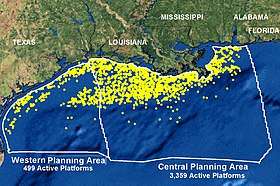
The more than 4,500 oil production platforms in the US portion of the Gulf of Mexico are the largest concentration of offshore platforms in the world, having more offshore platforms than the rest of the world combined.[27] The oil production platforms in the Gulf have also been called the largest artificial reef complex in the world.[6]
In 1979, Exxon relocated their experimental subsea production system from offshore Louisiana to a permitted artificial reef site off Apalachicola, Florida.[28] The first platform jacket was donated by Tenneco and towed from Louisiana to Pensacola, Florida.[28]
By 2000, 151 platforms had been converted to permanent reefs. Of these, 90 were towed to new locations and 61 were abandoned in place. Louisiana had 94 of the platforms-turned reefs, Texas 50, Alabama 4, and Florida 3.[28] Florida, which has a long-standing ban on offshore oil production, has requested and received a number of decommissioned oil platforms for creation of artificial reefs in Florida state waters.[29]
Offshore California
In contrast to the Gulf of Mexico states, old oil platforms have not been converted to artificial reefs in offshore California, the only other offshore oil-producing area in the contiguous 48 states. A number of reasons have been cited for this, primarily the strength of the environmental movement in California, its antagonistic relationship with the oil industry, and its reluctance to support any measure that would financially benefit the offshore oil industry.[30] Other differences include the smaller number of offshore platforms (27 off California, versus approximately 4,500 in the Gulf of Mexico), and the smaller portion of the California economy made up by oil and fishing.
The California legislature passed a bill allowing conditional partial removal of oil platforms in 2010, and the measure was signed by Governor Arnold Schwarzenegger. A.B. 2503 “allows a platform owner or operator to design a ‘partial removal’ plan for a platform and to apply for permission to implement it”.[31] The plan requires the approval of three agencies: The Department of Fish and Game (DFG), The Department of Ocean Protection Council (OPC), and the California State Lands Commission.[31] As of 2013, no oil platforms have been converted to permanent reefs.[1]
Brunei
Brunei has had a rigs-to-reefs policy since 1988. Offshore operator Shell Brunei Petroleum has towed numerous old platforms and jackets to two designated artificial reef areas located away from shipping lanes.[1]
Malaysia
The Baram-8 platform was damaged in a storm and collapsed to the seabed in 1975. It was made into an artificial reef.[1] As of 2013, Malaysia has no rigs-to-reefs program, but was studying the Baram-8 reef as an example.
In 2017, Dana and D30 Platform was laid out for rigs-to-reef in offshore Sarawak.
North Sea
Studies have concluded that oil platforms in the North Sea attract fish, and that a rigs-to-reefs policy there would benefit fishermen.[32] However, the highly publicized occupation of the Brent Spar North Sea oil platform by Greenpeace in 1995 has been highly influential in Europe. Despite scientific findings of the potential value of rigs-to-reefs in the North Sea,[5][11][33] the Oslo-Paris Commission (OSPAR), which has jurisdiction over North Sea oil development, has blocked rigs-to-reefs.[34][35]
Debates
Opposition to, and also support for, Rigs-to-Reefs comes from environmentalists, fisherman, oil companies, and others. California and the North Sea are each debating RTR. In California, legislation was proposed during the 2010 session to clear legal hurdles for RTR; the Coastal Commission held hearings, but then the legislation was tabled.[36] Even with the RTR successes in the Gulf of Mexico and Philippines,[37] differences in terrain, government entities, and concerned citizens generated conflict.
Fisheries
Some point out that the title “Rigs to Reefs” is somewhat of a misnomer. As Milton Love, a biologist with the UC Santa Barbara Marine Science Institute noted, the oil production platforms are not just potential artificial reefs: "They are in fact artificial reefs right now." The question to Rigs-to-Reef supporters is whether it is good public policy to remove established artificial reefs.[38]
A 2000 MMS report lists research that shows fish densities 20 to 50 times higher around oil and gas platforms than in nearby open water.[6] Divers assess fish populations surrounding platforms.[39] The report encourages recreational fisherman, divers and others who benefit from the increased density. Opponents claim that the greater density comes from an influx of nearby fish rather than increased total population.[10] Research on rockfish populations on oil rigs offshore California supports both theories.[19] In the North Sea, lumpsuckers have been found to use platforms for reproduction, brooding eggs directly on the structure itself.[11]
The high fish populations make both active and inactive oil platforms in the Gulf of Mexico and offshore California popular destinations for sport fishermen and the charter fishing industry.[40][41] The diversity of aquatic life on and near the platforms attracts recreational divers.[42] These groups tend to support Rigs-to-Reefs, and fear the loss of coral and fish habitat if the oil platforms are removed.[43]
Commercial fishing for red snapper in the Gulf of Mexico is seen as highly dependent on oil platform habitat, which provides a hard substrate for aquatic life that is otherwise scarce in much of the Gulf. Dr. Bob Shipp, chairman of the University of South Alabama Department of Marine Sciences, and director of the Alabama Center for Estuarine Studies, would like to see 100 percent participation in Rigs-to-Reefs, and said of removing unused oil rigs from the Gulf: “As a fisheries scientist, I think it’s a very big mistake,” He elaborated:
- “(The rigs) are all essential habitat really, from the mouth of the (Mississippi) River to (South) Padre Island, snapper are totally reliant upon artificial structure. Before the 1940s, when those rigs started going in, there was practically no snapper in the northwest Gulf. Now, more than half of the catch is from that area.”[44]
Those commercial fisherman who trawl generally oppose Rigs-to-Reefs because their nets may snag a rig, creating a hazardous situation. This is particularly the case in offshore California with bottom trawling commercial fishermen, who can foul their nets on the shell mounds that build up on the sea floor near the rig.[45] Several fisherman have reported tangling their nets on submerged rigs.[13]
Liability
Navigational mishaps and diving accidents may also occur around an artificial reef. Gulf of Mexico Rigs-to-Reefs participants have not yet reported any liability problems.[45]
Rigs-to-Reefs was first explored in 1979 when the first oil rig was transported from Louisiana to a Florida site.[46] This rig was the first of 5 Rigs-to-Reefs towed to Florida's coast. Louisiana was the first state to develop a program that allowed transfer of liability and ownership from the operator to the state.[12] Texas later followed this example. Rigs-to-Reef is now the core of both Louisiana and Texas' artificial reef programs.[20]
Under the original guidelines, the Minerals Management Service would not release an operator from liability unless another entity accepts ongoing liability for the rig.[6] If the reef is in state waters, the state typically accepts liability. In federal waters, liability typically goes to a private entity or to another MMS-approved agency.[15] Critics claim that the primary reason that operators support RTR is their desire to offload decommissioning costs and liability.[16] In 2001, the California legislature passed, although the governor then vetoed, a bill that would allow operators to transfer liability to another entity, while retaining liability for any pollution from the underlying well.[16]
Under the new policy issued June 2013, oil platforms in the Rigs-to-Reefs program must be deeded, and liability accepted by, the state government.[26]
Environmental groups
As with cap-and-trade and ecotourism, RTR attempts to enlist the private sector in helping the environment. To many environmentalists, any program which benefits the oil industry, by lower decommissioning costs, is suspect. Some charge that rigs-to-reefs is an excuse for ocean dumping. Environmental groups have long opposed oil companies and frame their critique around distrust of the industry, particularly with regard to Rigs-to-Reefs in offshore California.[22] "No other industry is allowed to leave a toxic mess for the state to manage and maintain at taxpayer expense" said Linda Krop, Chief council for the Santa Barbara-based Environmental Defense Center.[45]
The Environmental Defense Fund supports Rigs-to-Reefs in the Gulf of Mexico, as a way to preserve the existing reef habitat of the oil platforms.[47]
See also
- Artificial reef – A human-created underwater structure, typically built to promote marine life, control erosion, block ship passage, block the use of trawling nets, or improve surfing
- Spawning bed
- Sinking ships for wreck diving sites – Scuttling old ships to produce artificial reefs suitable for recreational wreck diving
References
- Brian Twomey, Artificial Reefs, CCOP/EPPM Workshop on End of Concession & Decommissioning, 12–14 June 2012. (PDF)
- "Rigs-to-Reefs Information: What is Rigs-to-Reefs and how does it relate to the mission of the Bureau of Safety and Environmental Enforcement?". Archived from the original on 3 June 2010. Retrieved 6 March 2009.
- National Oceanic and Atmospheric Administration, Gulf decommissioning and Rigs-to-Reefs, FAQs Archived 2013-11-09 at the Wayback Machine, 2012.
- Joanna D. E. Athanassopoulos, James Stanwood Dalton, and Adam P. Fischer, Off Shore Oil Platform Decommissioning, M.S. Thesis, June 1999, University of California Santa Barbara. (PDF)
- Todd, V.L.G.; Williamson, L.D.; Cox, S.E.; Todd, I.B.; Macreadie, P.I. (2019). "Characterizing the first wave of fish and invertebrate colonization on a new offshore petroleum platform". ICES Journal of Marine Science: fsz077. doi:10.1093/icesjms/fsz077.
- Dauterive, Les (2000). "Rigs-To-Reef Policy, Progress, and Perspective". OCS Report. U.S. Department of the Interior: 1–12.
- Fowler, AM; Jørgensen, A-M; Svendsen, JC; Macreadie, PI; Jones, DO; Boon, AR; Booth, DJ; Brabant, R; Callahan, E; Claisse, JT; Dahlgren, TG; Degraer, S; Dokken, QR; Gill, AB; Johns, DG; Leewis, RJ; Lindeboom, HJ; Linden, O; May, R; Murk, AJ; Ottersen, G; Schroeder, DM; Shastri, SM; Teilmann, J; Todd, V; Van Hoey, G; Vanaverbeke, J; Coolen, JW (2018). "Environmental benefits of leaving offshore infrastructure in the ocean". Frontiers in Ecology and the Environment. 16 (10): 571–578. doi:10.1002/fee.1827.
- U.S. Department of the Interior, Minerals Management Service, Gulf of Mexico OCS Region. Rigs-to-Reefs Policy, Progress, and Perspective (Report). OCS Report MMS 2000-073. Retrieved 6 March 2009.CS1 maint: multiple names: authors list (link)
- Archived 21 August 2008 at the Wayback Machine State of California State and Lands Commission
- Bell, Mel; et al. (January 1997). "Guidelines for Marine Artificial Reef Materials". Gulf States Marine Fisheries Commission: 1–123. Cite journal requires
|journal=(help) - Todd, V.L.G.; Lavallin, E.; Macreadie, P. (2018). "Quantitative analysis of fish and invertebrate assemblage dynamics in association with a North Sea oil and gas installation complex". Marine Environmental Research. 142: 69–79. doi:10.1016/j.marenvres.2018.09.018. PMID 30274717.
- Kaiser, Mark J. (2006). "The Louisiana Artificial Reef Program". Marine Policy. 30 (6): 605–623. doi:10.1016/j.marpol.2005.04.005.
- "Oil watchdog". Archived from the original on 15 April 2013.
- Sector Notebook Project; Office of Enforcement and Compliance Assurance, October 2000
- Schroeder, Donna M., & Love, Milton S. (2004). "Ecological and political issues surrounding decommissioning of offshore oil facilities in the Southern California Bight". Ocean and Coastal Management. 47 (1–2): 21–48. doi:10.1016/j.ocecoaman.2004.03.002.CS1 maint: multiple names: authors list (link)
- "Rigs-to-Reefs issues". Archived from the original on 25 May 2008. Retrieved 24 July 2009.
- Archived 21 August 2008 at the Wayback Machine CA.gov Rigs-to-Reefs Workshop
- The Greater Baton Rouge Business Report 1998
- Love, Milton; et al. (August 1999). "Fish assemblages around seven oil platforms in the Santa Barbara Channel area". Marine Science Institute University of California: 96–117. Cite journal requires
|journal=(help) - Archived 13 May 2008 at the Wayback Machine Louisiana Department of Wildlife and Fisheries
- "Archived copy". Archived from the original on 8 July 2010. Retrieved 19 June 2012.CS1 maint: archived copy as title (link)
- Rothbach, Dan (2007). "Rigs-to-Reefs: Refocusing the Debate in California". Duke Environmental Law and Policy Forum. 17 (283): 283–295.
- "Basic Information | Compliance and Enforcement | U.S. EPA". Epa.gov. Retrieved 19 June 2012.
- Bureau of Ocean Energy Management, Rigs-toReefs program
- James A. Watson, "Interim policy document" Archived 10 November 2013 at the Wayback Machine, Bureau of Safety and Environmental Enforcement, 21 June 2013.
- "Archived copy". Archived from the original on 9 December 2012. Retrieved 25 November 2013.CS1 maint: archived copy as title (link)
- Dauterive, Les (2000). "Rigs-To-Reefs policy, progress, and perspective". In: Hallock and French (Eds). Diving for Science...2000. Proceedings of the 20th Annual Scientific Diving Symposium. American Academy of Underwater Sciences. Retrieved 7 January 2011.
- API Energy: Rigs to Reef Programs Create Valuable Fish Habitat
- Gary Polakovic, Legacy of an Offshore Disaster, Los Angeles Times, 28 Jan. 1999.
- Hecht, Sean B. "California's New Rigs-to-Reef Laws". UCLA Institute of the Environment and Sustainability.
- Aud Vold Soldal, Ingvald Svellingen, Terje Jørgensen, and Svein Løkkeborg, “Rigs-to-reefs in the North Sea: hydroacoustic quantification of fish in the vicinity of a ‘semi-cold’ platform”, ICES Journal of Marine Science, 59: S281–S287, 2002.
- Todd, V.L.G.; Pearse, W.D.; Tregenza, N.C.; Lepper, P.; Todd, I.B. (2009). "Diel echolocation activity of harbour porpoises (Phocoena phocoena) around North Sea offshore gas installations". ICES Journal of Marine Science. 66 (4): 734–745. doi:10.1093/icesjms/fsp035.
- Dolly Jørgensen, OSPAR’s exclusion of rigs-to-reefs in the North Sea Ocean & Coastal Management, v.58, Mar. 2012, p.57–61.
- “Sinking Prospect: Oil Rigs and Greenpeace in the North Sea”, Solutions Journal, v.4 n.4, Sept. 2013
- Baine, Mark. “Short Communication: The North Sea Rigs-to-Reef debate,” Journal of Marine Science 59 (2002): S277-S280.
- Ranjith, M.W.; De Silva, N., “The Coastal Resources Management Program in Brunei Darussalam. Ocean and Coastal Management 38 (1998) 147-160
- Sally Ann Connell, “Is Rigs-to-Reefs Best Plan for Oil Rigs?”, Los Angeles Times, 20 June 1999.
- SA Cox; CR Beaver; QR Dokken & JR Rooker. (1996). "Diver-based under water survey techniques used to assess fish populations and fouling community development on offshore oil and gas platform structures". In: MA Lang, CC Baldwin (Eds.) the Diving for Science…1996, "Methods and Techniques of Underwater Research". Proceedings of the American Academy of Underwater Sciences (16th Annual Scientific Diving Symposium). Retrieved 6 March 2009.
- Voodoo Fishing Charters, Offshore rig fishing in Louisiana Archived 19 September 2013 at the Wayback Machine, accessed 6 Nov. 2013.
- Venice Outdoors, Oil rigs Archived 25 July 2013 at the Wayback Machine, accessed 6 November 2013
- Channel Island Adventures, Oil rigs, accessed 6 November 2013.
- Melissa Gaskill, "In Its First Life, an Oil Platform; in Its Next, a Reef?", New York Times, 17 June 2012.
- M.A. Fisher, "359 rigs slated for decommissioning, leading scientist says action is detrimental to red snapper plan", The Louisiana Sportsman, Feb 2013.
- Archived 19 July 2008 at the Wayback Machine CDNN-"California Rigs to Reefs Battle Creates Strange Alliances"
- Minerals Management Service: History of Rigs to Reefs offshore Florida
- Jack Sterne, "EDF stands with fishermen in calling for suspension of rig removal policy", EDF Oceans, 24 Apr. 2012.
External links
Government
- US Bureau of Safety and Environmental Enforcement, Rigs-to-Reefs
- California State Lands Commission, Rigs to reefs in California
- Louisiana Department of Wildlife and Fisheries, Artificial reef program
- Mississippi Department of Marine Resources, Artificial reefs: rig to reef
- Texas Department of Parks and Wildlife, Rigs-to-Reefs
News
- Chip Reid, "Unused oil rig becomes Garden of Eden", (video) CBS Evening News, 10 July 2013.